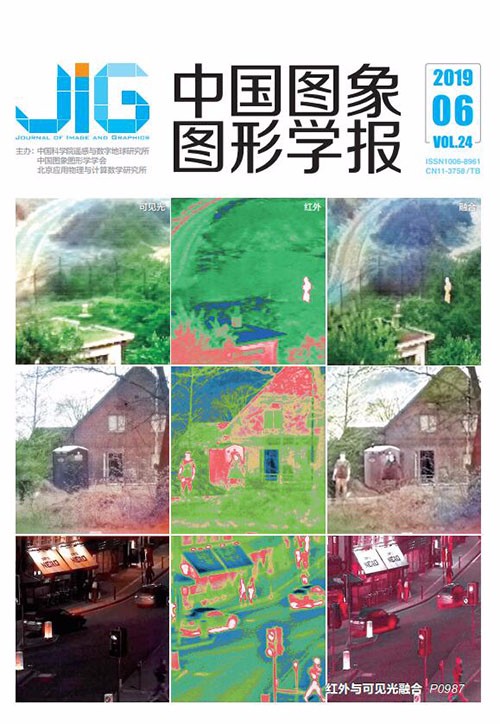
加强边缘感知的盲去模糊算法
摘 要
目的 拍摄过程中,如果摄像机进行了错误的聚焦,就会得到模糊的图像,如何将模糊图像变得清晰成为一个亟待解决的问题。目前关于图像的去模糊方法多采用基于模糊核约束的卷积模型。但是由于实际应用中很难准确获取模糊核的信息,同时计算机也存在精度限制,计算结果与实际物理模型有偏差,因而去模糊的主要挑战为:如何精确地估计模糊核,以及如何在复原过程中减弱由于精度限制造成的振铃效应。方法 振铃效应是指图像的灰度剧烈变化处产生的震荡,类似于钟被敲击后产生的波状空气震荡。在图像复原过程中,此效应通常发生在梯度变化较大的边缘区域附近。本文对此进行研究,在去模糊过程中引入边缘信息作为约束条件,以改善模糊核的估计,并通过抑制边缘区域的反卷积,抑制图像复原过程中的振铃效应。算法主要分为如下3个部分:1)设计了适用于模糊图像的边缘提取算法;2)利用边缘信息设计了加强边缘感知的反卷积算法;3)提出并设计了安全检测子,以保证算法在边缘区域复原的完整性。结果 实验结果表明,在没有先验知识的情况下,本文方法可以较好地恢复图像细节,并有效抑制振铃效应。较之传统的去模糊处理算法,本文方法在性能上有较大提高。比如,相比于Chan、Krishnan以及Hu的方法,本文方法在峰值信噪比指标上分别提高了25.73%、3.52%和4.43%,在结构相似性指标上分别提高了7.67%、1.63%和3.59%。同时,与基于深度学习的方法相比,本文方法不依赖于数据集,鲁棒性更强。结论 本文方法可以较好地恢复图像细节,并抑制振铃效应,同时比深度学习方法适用范围更广。
关键词
Blind image deblurring with reinforced use of edges
Qiu Feng1,2, Hou Fei1,2, Yuan Ye1,2, Wang Wencheng1,2(1.State Key Laboratory of Computer Science, Institute of Software, Chinese Academy of Sciences, Beijing 100190, China;2.University of Chinese Academy of Sciences, Beijing 100049, China) Abstract
Objective Image deblurring has been an active research area over the last decade. Image blurring may bring serious problems in our daily life. For example, almost all cities have installed electronic monitoring and controlling systems to capture various things on robbery, accident, or other useful information. When people and vehicles are moving fast, the captured images become blurry. Moreover, a camera that is out of focus causes image blurring. With the wide use of electrical camera equipment, blurring caused by movement and out of focus has become widespread. Thus, deblurring in traffic monitoring, astronomical remote sensing, and public security investigation has a great value. Method Although the topic of image blur analysis has attracted considerable attention in recent years, most previous works focus on solving the deblurring problem. On the contrary, general blur detection is seldom explored and remains far from practical application. In terms of blurring kernel, image deblurring algorithms can be divided into two categories:blind image deconvolution (BID) and non-blind image deconvolution (NBID). BID recovers the focused image with unknown blurring kernel. By contrast, the NBID deblurs image with known blurring kernel. In practice, the blurring kernel is often difficult to determine beforehand. Therefore, BID is more widely used than NBID. However, the blind deconvolution algorithm still has challenges:1) The first is how to estimate the blurring kernel accurately. The reason is that the blurring kernel is susceptible to noise, which might result in kernel misestimation. 2) The ringing artifacts may occur around prominent edges of the image. In this paper, we discuss these two challenges. We focus on a deblurring algorithm based on conspicuous edge detection. We propose a novel fused edge detection method based on the modified edge operators and morphological edge detection to improve the deblurring effect. The proposed algorithm accurately extracts the conspicuous edges. Then, we use conspicuous edges to estimate the blur kernel and deconvolve the image. Moreover, we obtain the gap mask and subtract it to retain the necessary gaps. The pixels are protected from being missing because abundant edge pixels are avoided. Results show that our scheme significantly enhances the deconvolution results especially for reducing the ringing artifacts. Result We compare our algorithm with Chan's, Krishnan's, and Hu's algorithms to evaluate its performance. First, the algorithms are tested on basic graphic elements, such as straight line, broken line, and curve. For the three elements, Chan's method causes several ringing artifacts. For the straight line, the edges remain blurred when processed using Krishnan's and Hu's methods. The blurred line processed by our method is sharp in the edge without ringing artifacts. For the broken line, Krishnan's method spreads the black points to the white region and crosses colors between each other. Hu's method shows no ringing artifacts and cross-color, but the vertex is round and not sharp enough. The element processed by our method has slight ringing artifacts in the border but remains sharp. For the curve, Krishnan's method also has drawbacks on cross-color between the black and white regions. In addition, the curve has become less smooth. Our method and Hu's method have achieved good results but with slight ringing artifacts under the curve. These comparisons show that our algorithm and Hu's algorithm obtain the best results for maintaining the sharpness and reducing the ringing artifacts. Second, we test these algorithms by using natural images. Results indicate that Chan's method has excellent details, but it has the most evident ringing artifacts. Krishnan's method has good deblurring results but most of them are too sharpened. Hu's method performs well on low-light images, but details are missing in the results. Our method has the least ringing artifacts at the edges and detailed region of the image. Experimental results demonstrate that our edge-aware deblurring algorithm can recover better image details and better suppress the ringing effect than conventional deblurring algorithms. In comparison with Chan's, Krishnan's, and Hu's methods, our proposed algorithm achieves the best accuracy in terms of PSNR (peak signal to noise ratio) and SSIM (structural similarity index). The average values of improved PSNR are 25.73%, 3.52%, and 4.43%, respectively. SSIM values increase to 7.67%, 1.63%, and 3.59%, respectively. The method proposed in this study is more general than other deep learning-based methods and has no dependence on datasets. Conclusion The results of our algorithm are better than those of conventional operator-based deblurring methods in either PSNR or SSIM. Our algorithm is superior to other algorithms in terms of reducing ringing artifacts.
Keywords
image deblurring blurring kernel estimation ringing artifacts fused edge detection weighted blind deconvolution
|



 中国图象图形学报 │ 京ICP备05080539号-4 │ 本系统由
中国图象图形学报 │ 京ICP备05080539号-4 │ 本系统由